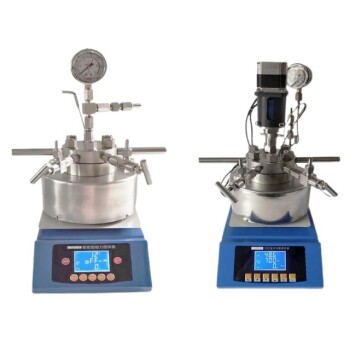Short path distillation operates under a vacuum to lower the boiling point of materials, making it ideal for heat-sensitive compounds. The pressure for short path distillation can go as low as 0.001 mbar at the heating surface, which is significantly lower than conventional distillation methods. This low pressure allows for efficient separation of components at reduced temperatures, preserving the integrity of sensitive materials. The process involves heating the material in a boiling flask, maintaining the condenser at a specific temperature, and using a vacuum to draw vapors into the condenser for collection. This method is highly effective for achieving high-purity distillates with minimal equipment.
Key Points Explained:

-
Operating Pressure Range:
- Short path distillation operates under a vacuum, with pressures as low as 0.001 mbar at the heating surface. This ultra-low pressure is crucial for reducing the boiling point of materials, enabling the distillation of heat-sensitive compounds without degradation.
- Compared to conventional wiped film evaporators, which typically operate down to 1 mbar, short path evaporators offer a much finer vacuum, making them suitable for high-purity applications.
-
Role of Vacuum in Short Path Distillation:
- The vacuum is used to draw vapors from the evaporating flask into the condenser. This process facilitates the separation of components by cooling the gas-phase materials back into liquids, which are then collected as distillate.
- By reducing the operating pressure, the boiling temperature of the material is significantly lowered, allowing the process to operate at temperatures that are safe for heat-sensitive compounds.
-
Equipment and Setup:
- Short path distillation requires minimal equipment, including specialty flasks, test tubes, beakers, and small glassware. This setup is compact and does not require a large workspace, making it accessible for small-scale operations.
- The process involves assembling and securing the glassware, applying grease to joints to ensure a proper seal, and orienting the receiving cow correctly to collect fractions efficiently.
-
Temperature Control:
- Temperature monitoring is critical in short path distillation. The condenser is typically maintained at 50°C to ensure efficient cooling of the vapors.
- The material in the boiling flask is heated gradually to avoid thermal degradation, and the vacuum ensures that the distillation occurs at lower temperatures.
-
Applications and Advantages:
- Short path distillation is ideal for applications requiring high purity levels, such as the distillation of essential oils, cannabinoids, and other heat-sensitive compounds.
- The ability to operate at extremely low pressures and temperatures makes it a preferred method for fine vacuum distillation and high evaporation rate applications.
-
Process Steps:
- Preparation: The material is prepared through winterization and decarbing to remove impurities and activate compounds.
- Loading: The prepared material is loaded into the boiling flask.
- Assembly: Glassware is assembled and secured, with grease applied to joints to ensure a proper vacuum seal.
- Vacuum Application: A vacuum is applied to draw vapors into the condenser, where they are cooled and collected as distillate.
- Monitoring: Temperatures are monitored throughout the process to ensure optimal conditions for distillation.
In summary, short path distillation operates at extremely low pressures (down to 0.001 mbar) to facilitate the separation of heat-sensitive materials at reduced temperatures. This method is highly efficient, requires minimal equipment, and is ideal for achieving high-purity distillates.
Summary Table:
| Key Aspect | Details |
|---|---|
| Operating Pressure Range | As low as 0.001 mbar, ideal for heat-sensitive materials. |
| Role of Vacuum | Lowers boiling points, enabling safe distillation of sensitive compounds. |
| Equipment | Minimal setup: flasks, test tubes, beakers, and small glassware. |
| Temperature Control | Condenser maintained at 50°C for efficient cooling. |
| Applications | Essential oils, cannabinoids, and other heat-sensitive compounds. |
| Process Steps | Preparation, loading, assembly, vacuum application, and monitoring. |
Discover how short path distillation can enhance your process—contact us today to learn more!














